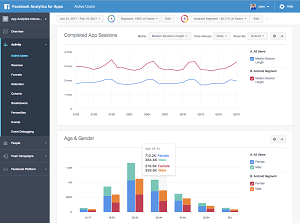News
Facebook Analytics for Apps Hits 1 Million Milestone, Adds Features
- By David Ramel
- February 21, 2017
Facebook today announced new functionality in its Analytics for Apps tool for mobile and Web development, while announcing it has now been used in more than 1 million apps, Web sites and bots.
Launched at the company's F8 developer conference in 2015, Facebook Analytics for Apps helps companies understand their app users, measure how they use an app across different devices and improve marketing campaigns.
Still a month shy of its two-year anniversary, the analytics tool has been steadily improved, recently adding mobile push notifications and cross-platform functionality and bot support.
While noting that it surpassed the 1 million usage milestone, the company announced the ability to compare data for two customer segments side-by-side and new support for domain-level reporting.
Customer segments refer to the slicing and dicing of the user base according to specific attributes such as home country, type of device or other demographics. The new side-by-side comparison capability will let developers instantly see, for example, how many Android users complete app sessions compared to all users, and even dig deeper into demographics such as age and gender.
 [Click on image for larger view.]
Comparing Two Customer Segments Side-by-Side (source: Facebook)
[Click on image for larger view.]
Comparing Two Customer Segments Side-by-Side (source: Facebook)
"With this latest update, you can now compare two customer segments side-by-side to see how important activity, such as active users, revenue, and events, differs between them," Facebook said in a blog post today. "For example, an e-commerce business can use side-by-side comparisons to answer questions such as how many people are viewing their store's weekly specials in their native iOS app vs. on their mobile Web site."
The new domain-level reporting, meanwhile, adds on to the aforementioned cross-platform functionality that let developers track metrics across iOS, Android and Web all in one place. Now, app publishers can see what Web sites are driving business goals.
"You'll now be able to build breakdowns to analyze events by their referring domain, or use referring domains as a condition when building a customer segment to filter your reports," Facebook said.
"For example, that same e-commerce business can dig further into their mobile Web site performance to understand exactly which Web sites are referring the most people to their weekly specials page. To identify optimization opportunities, a segment can then be created of customers from these top referring Web sites to provide visibility into how this group progressed through their mobile Web site's purchase flow."
More information is available in a quickstart guide.
About the Author
David Ramel is an editor and writer at Converge 360.